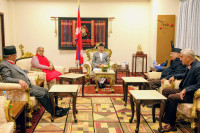Opinion
Share and share alike
South African model of resource distribution provides a template for revamping our own practices
Kl Devkota
It wouldn’t be remiss to state that the overall resource distribution in Nepal is controlled by a handful of influential people under the guise of the people’s representatives. Dozens of reports published time and again in newspapers, research reports, budget speeches, the government’s own red book, and reports from the Office of the Auditor General and Financial Comptroller General Office, along with publications from the government and non-government agencies, clearly indicate that state resources continue to be distributed under the instructions of key leaders from the major political parties and the ministers of powerful ministries. The misuse of state funds becomes particularly obvious towards the end of every fiscal year when there is a mad rush to spend excess money.
Inequitable distribution
For one example, let us take the Ministry of Irrigation, where budgets for 9,160 different small projects have been distributed across the nation, according to the Red Book Part Two of the current fiscal year. Among them, the greatest number of projects, 339 (3.70 percent), has been selected for Nuwakot district, whereas Siraha district gets only 39 (0.43 percent) projects, the least number. Another example is budget allocation for roads. As per the same book, a budget of Rs 1.5 billion has been allocated for Kathmandu district. However, Tehrathum district will receive only Rs 7.4 million, which is 141 times less than what Kathmandu gets. Likewise, 500 projects have been selected for Kathmandu district while Manang district has only eight projects. Almost all these projects have been selected by avoiding standard planning and budgeting procedures and without analysing their effects on long-term development. Considering all these facts, the National Planning Commission has decided not to publish this red book from the forthcoming fiscal year.
It goes without saying that presently, the resource distribution practice is discriminatory. When it comes to distribution of resources for districts, influential leaders and ministers focus solely on their own districts and constituencies at the expense of those who do not have regular access to decision-making authorities. The needs of regions across the country need to be treated equally by the government but, instead, state resources have been captured by the elite, leading to the further marginalisation of areas and people already devoid of resources.
As the Constituent Assembly (CA) is presently drafting a new constitution, a discussion on the equitable distribution of state resources on a proportionate basis is very pertinent. The South African model of resource distribution is presented here for reference with a hope that the CA can make use of it and ensure equitable resource sharing.
The South African model
South Africa is a federal country with a population of 54 million. It adopted a new constitution in 1996, which provides for a three-tiered governance system—central, nine provinces, and local governments. Article 214 of this constitution is related to equitable sharing and allocations of resources, which has the provisions: “(1) An Act of Parliament must provide for (a) the equitable division of revenue raised nationally among the national, provincial and local spheres of government; b) the determination of each province’s equitable share of the provincial share of that revenue; and (c) any other allocations to provinces, local government or municipalities from the national government’s share of that revenue, and any conditions on which those allocations may be made. (2) The Act referred to in subsection (1) may be enacted only after the provincial governments, organised local governments, and the Financial and Fiscal Commission have been consulted, and after any recommendations of the Commission have been considered.”
More specifically, the constitution requires that every year, a Division of Revenue Act determines the equitable division of nationally raised revenue between the national government, the provinces, and local governments/municipalities. Furthermore, the Intergovernmental Fiscal Relations Act (1997) prescribes the process for determining equitable sharing and allocation of nationally-raised revenue. Sections 9 and 10(4) of the Act set out the consultation process to be followed by the Financial and Fiscal Commission (FFC), including recommendations regarding the division of revenue. Section 214 of the constitution requires that the FFC’s recommendations be considered before tabling the division of revenue. Furthermore, the Minister of Finance is required to table a Division of Revenue Bill with the annual budget at the National Assembly. The bill must be accompanied by an Explanatory Memorandum, outlining how government took the FFC’s recommendations into account when determining the division of revenue.
What can be learnt?
It is necessary to mention here that South Africa has adopted a formula-based approach to the equitable division of revenue through a powerful and independent FFC, which has seven constitutional members. The recommendations of these members on the equitable division of the national budget among the three spheres of governments (vertical division) and across provinces and local governments (horizontal division) must be duly incorporated into the division of revenue bill.
In practice, parliamentarians are fully empowered in the resource distribution procedure and the formula-based allocation system is followed in all government agencies. A similar practice has been adopted in India, which has a central and provincial finance commissions. Not only that, another similar practice can be observed in Australia, which has the Commonwealth Grants Commission for this very purpose at both the central and provincial levels. Except for these two countries, other federal countries do not seem to have as effective resource distribution bodies as does South Africa.
In Nepal’s case, neither a vertical nor a horizontal allocations system is present. Instead, inequitable budget distribution is widely practised, which allocates a nominal budget even to basic service delivery ministries like education, health, agriculture and livestock, and local development. Furthermore, the role of parliament members is also marginalised in the resource distribution procedure.
Despite all the ills, a few positive initiatives have been observed in the process of drafting the new constitution. A model for a National Finance Commission has been proposed and the Political Dialogue and Consensus Committee has recommended constitutional rights to this commission. However, its role is yet to be outlined.
In conclusion, it would be advisable to adopt a budget distribution provision similar to that of South Africa’s in our new constitution, which will create an environment for balanced socio-economic development across the districts. Like in South Africa, the proposed financial commission should be made powerful and independent, so that it will be able to distribute state resources on the basis of equity and proportion.
Devkota holds a PhD in fiscal decentralisation and is a former member of the Local Bodies Fiscal Commission




 7.12°C Kathmandu
7.12°C Kathmandu











